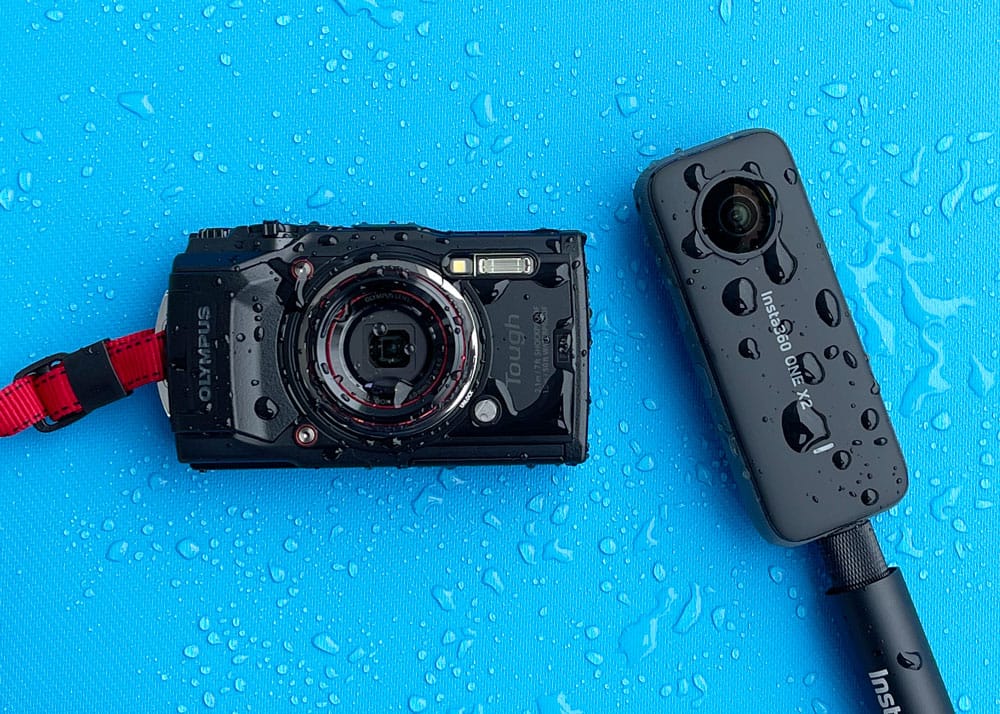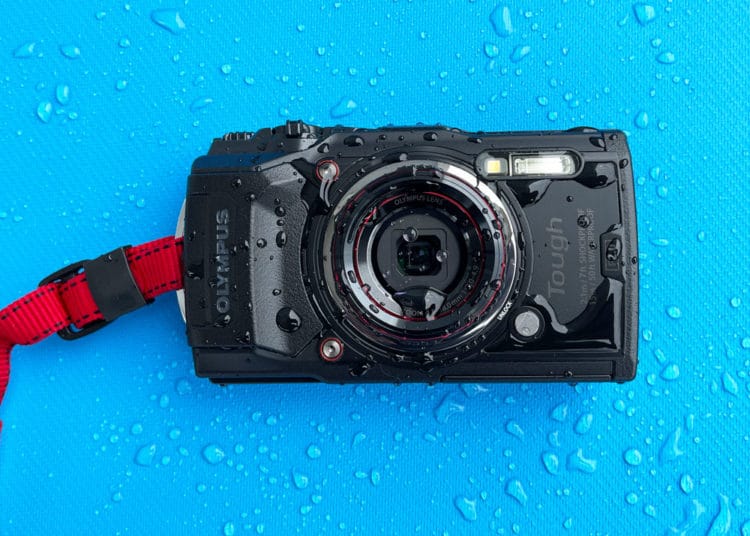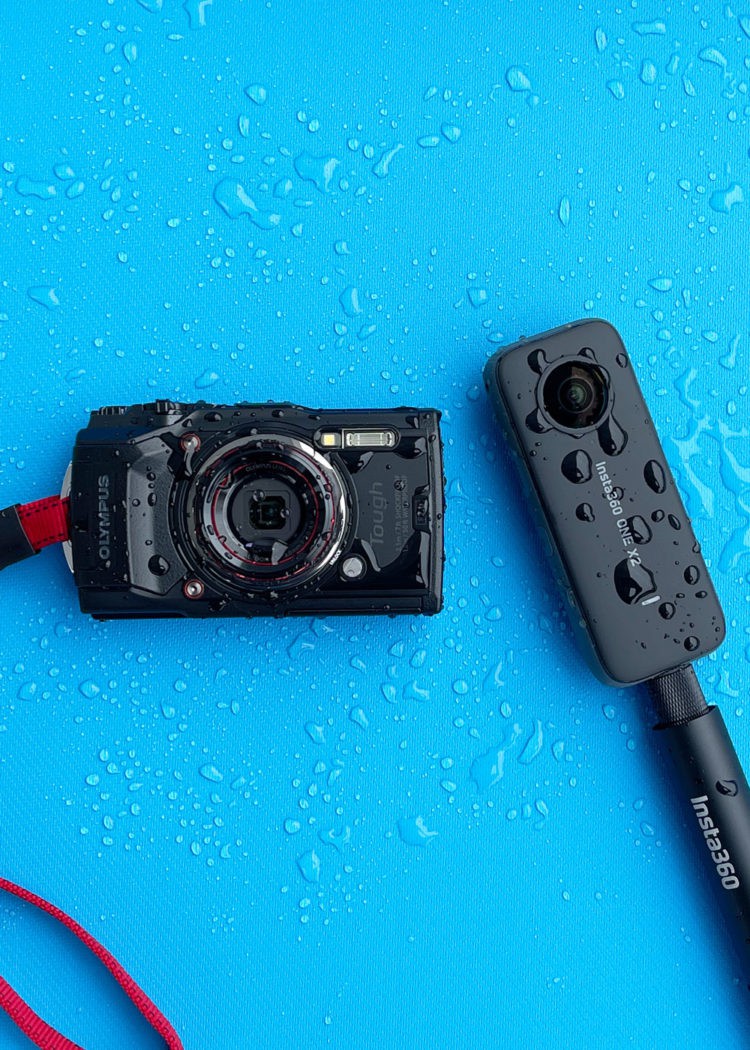If you’re confused about IPX ratings on electronic devices, you aren’t alone. In this guide, you’ll learn the basics of IPX waterproof ratings, including an explanation of both numbers (solid and water) and what it all means. Plus an IPX rating chart of increasing protection against intrusions.
If you’re looking for the best IPX waterproof rating, you should choose an action camera with IPX7 or IPX8 rating. Both can be safely immersed in water – and will keep working under heavy rain, the mist from breaking waves, and even llama spit episodes. Here’s what you need to know about IPX waterproof ratings.

In this post, you’ll learn the difference between IP ratings for solid and liquid intrusions, find examples of each category, an IPX rating chart for each category. Plus IPX rating of popular cameras and other electronic devices.
What is IPX Rating?
What is IPX Rating? The IPX rating measures the level of protection against water, dust, and other debris that could enter your electronic device.
What Does IP Stand For?
In mechanical and electronic devices, IP stands for Ingress Protection. This rating code classifies the degree of protection an electronic device has against water, dust, and other intrusions.
This is an international rating standard IEC 60529, published by the European Committee for Standardization (CEN).
Do IP Ratings Matter?
IPX ratings are more accurate than just “waterproof”. Some cameras (like the GoPro Hero10 Black) can be submerged to just 33 ft (10 m) and are advertised as waterproof.
Compare that with a decent dive watch (like the Citizen Eco-Drive Promaster) that can go to depths of 1000 ft (300 m) and is listed as just water-resistant.
By using a standardized rating system, consumers can accurately understand the level of protection for each device. Each product must be tested and independently certified before using an IP rating. Companies can’t use an IPX without being certified first.
What the numbers mean
There are 3 components to each IP rating.
- IP: Each IP rating begins with IP as the first two characters.
- First digit (Solid Particle): Rating for solid materials, like dust, sand, soil, and even fingers. Scale of 0-6.
- Second Digit (Liquid): Rating for water resistance. Scale of 0-9.
The higher the number, the better the protection. This is true for both the first and second digits.
In the past, a third digit was used to convey mechanical impact resistance but has since been abandoned.
What Do the X and 0 Mean?
- X: The letter X can be used in place of either digit. This means that either there is insufficient data, or that that rating is focused on just one element.
- 0: The zero is used when there is no protection provided for that element.
The X is commonly used because IPX ratings can be confusing for consumers. By only displaying one digit, the level of protection is more easily understood.
What Do IPX Ratings Look Like?
Here’s what an IP rating looks like IPX7.
How to Understand The IP Rating
Here’s an example of a camera with both IP ratings, for solids and water.
Dustproof and waterproof ratings are different. The Olympus Tough TG-6 is rated for both solids and water.
- Dustproof: IP6X (Dust-tight)
- Waterproof: IPX8 (50 ft, 15 m)
The combined IP rating for the TG-6 is IP68.
All three IP ratings are correct. Use the X to allow consumers to focus on the other protection level.

IPX Waterproof Rating
Here are the details for each IPX waterproof rating.
IPX Rating Chart
| IPX Rating | IPX Rating Meaning |
|---|---|
| IPX0 | No protection from water ingress. |
| IPX1 | Dripping water. Test lasts 10 minutes. Water volume measures 0.039 inches (1 mm) in rainfall per minute. |
| IPX2 | Dripping water with device tilted at 15° from normal position. Texted in 4 different positions. Water volume equals 0.12 inches (3 mm) per minute. |
| IPX3 | Spraying water. 5 minute spray test of 10 liters per minute. |
| IPX4 | Splashing water from any direction, using an oscillating tube or spray nozzle. 10 minute duration. |
| IPX5 | Water jets. Water sprayed for 3 minutes at 4.4 psi (30 kPa), with 12.5 liters per minute. |
| IPX6 | Powerful water jets. Water sprayed for 3 minutes at 15 psi (100 kPa), with 100 litres per minute. IPX6K: Powerful water jets (increased pressure). Water sprayed for 3 minutes at 150 psi (1000 kPa), |
| IPX6K | Powerful water jets (increased pressure). Water sprayed for 3 minutes at 150 psi (1000 kPa), with 100 liters per minute. |
| IPX7 | Immersion (1 meter or less). Up to 3 ft 3 in (1 meter). Test lasts 30 minutes, with depth of 39 inches (1000 mm) |
| IPX8 | Immersion (1 meter or deeper). 3 ft 3 in (1 meter) or deeper. Test length and depth specified by manufacturer. Commonly, this test is up to 9.8 ft (3 meters). Actual test depth noted on each device spec sheet. |
| IPX9K | Powerful, hot water jets. This 3-minute test subjects devices to 14-16 liters per minute of 176 °F (80 °C) water. This rating corresponds to IPx9. It uses the same water test as IP69K. |
Here’s the explanation of each IPX rating for waterproofness.
- IPX0: No protection from water ingress.
- IPX1: Dripping water. Test lasts 10 minutes. Water volume measures 0.039 inches (1 mm) in rainfall per minute.
- IPX2: Dripping water with device tilted at 15° from normal position. Texted in 4 different positions. Water volume equals 0.12 inches (3 mm) per minute.
- IPX3: Spraying water. 5 minute spray test of 10 liters per minute.
- IPX4: Splashing water from any direction, using an oscillating tube or spray nozzle. 10 minute duration.
- IPX5: Water jets. Water sprayed for 3 minutes at 4.4 psi (30 kPa), with 12.5 liters per minute.
- IPX6: Powerful water jets. Water sprayed for 3 minutes at 15 psi (100 kPa), with 100 liters per minute.
- IPX6K: Powerful water jets (increased pressure). Water sprayed for 3 minutes at 150 psi (1000 kPa), with 100 liters per minute.
- IPX7: Immersion (1 meter or less). Up to 3 ft 3 in (1 meter). Test lasts 30 minutes, with depth of 39 inches (1000 mm)
- IPX8: Immersion (1 meter or deeper). 3 ft 3 in (1 meter) or deeper. Test length and depth specified by manufacturer. Commonly, this test is up to 9.8 ft (3 meters). Actual test depth noted on each device spec sheet.
- IPX9K: Powerful, hot water jets. This 3-minute test subjects devices to 14-16 liters per minute of 176 °F (80 °C) water. This rating corresponds to IPx9. It uses the same water test as IP69K. This rating is rarely used.
NEMA Rating Vs IP Rating (Chart)
The National Electrical Manufacturers Association (NEMA) defines enclosure types, in a similar but distinct manner to IP codes.
Here is a rough translation between these parallel codes. While they don’t correspond directly, these are similar.
| NEMA Rating | IP Rating |
|---|---|
| 1 | IP20 |
| 2 | IP22 |
| 3, 3X, 3S, 3SX | IP55 |
| 3R, 3RX | IP24 |
| 4, 4X | IP44, IP66, IP65 |
| 5 | IP53 |
| 6 | IP67 |
| 6P | IP68 |
| 12, 12K, 13 | IP54 |
It’s worth noting that NEMA ratings are more strict, as they also require additional features. These include function below-freezing and hazardous area enclosures.
Devices with IPX Ratings: IPX3 to IPX8
Devices with IPX3 Rating
These two drones are rated IPX3. Most consumer and prosumer drones don’t carry any IPX rating.
- DJI M200 Series: IP43
- Parrot Anafi: IP53
Devices with IPX4 Rating
- AirPods Pro: They are sweat and water-resistant but not fully waterproof.
Devices with IPX5 Rating
- DJI Matrice 300 Drone: IP45
Devices with IPX6 Rating
Many trail cameras are rated IPX6. We have Campark and Apeman trail cameras, all rated IPX6.
Devices with IPX7 Rating
Here are a couple of examples of devices with an IPX7 rating.
- iPhone 10: IPX7
- DJI Agras T16 Drone: IP67
- Sony SRS-XB33 Bluetooth Speaker: IP67
Devices with IPX8 Rating
For consumer electronics, IPX8 is the best waterproof rating. Here are some examples of devices that carry this rating.
- Insta360 One X2
- iPhone 13 (also iPhone 12 and 11)
- Olympus Tough TG-6
But that doesn’t mean that all IPX8 devices are equal. Check the manufacturer’s specs for depth ratings for your specific device.
What’s the Best IPX Rating?
For action camera gear, you should be looking for IPX7 or IPX8. Both ratings are safe for water immersion. That means rain, snow, dew, and ocean spray won’t harm your gear.
What is GoPro IPX Rating?
I’m unable to find the IP rating for any GoPro camera. What this probably means is that they didn’t pay for that testing and certification.
Not publishing an IPX rating is unusual because major competitors make good use of this rating on their sales and spec sheets.
All GoPro cameras since the Hero5 (and to the current Hero11) are waterproof without an external case, for depths up to 33 feet (10 meters). The Max is the exception, which is waterproof to just 16 feet (5 meters).
Here’s our full GoPro Waterproof Guide to all models and depth specs.
What is Apple Watch IPX Rating?
Unlike most cameras and phones (including iPhones), most older Apple watches don’t carry an IPX rating.
Rather, they use a watch depth rating, common for all watches. The exception is the first-generation Apple watches, which carried an IPX7 rating.
Here’s how the Apple watches stack up.
- Apple Watch Series 1 (and 1st Gen): IPX7
- Apples Watch Series 2 (and newer): 50 meters water resistant
- Apple Watch Series 7: IP6X (Dust Resistant). Water resistant to 50 meters). Not all straps are water-resistant. No IPX (waterproof) rating are provided.

While all GoPro cameras are waterproof, it’s a good idea to mount yours to a GoPro float pole. If you drop it over water, it will float to the top.
Your Turn
And there you have it, our IPX rating chart. What IPX rating are you looking for in your device? What type of adventures do you have planned? Join me in the comments!
- About the Author
- Latest Posts
Hey, I’m Bryan! I’m a content creator and co-founder of Storyteller Tech.
Experienced GoPro Videographer: I’ve been shooting with GoPro cameras for over 11 years. My first GoPro was the Hero3 Silver, bought for a Galapagos work trip in 2012. Today I own 20+ action cameras, including GoPro, DJI, and Insta360 cameras.
Professional Creator: Dena and I have developed video and content marketing plans for numerous international travel brands. And we also run several content businesses.
Bryan also creates at Storyteller.Travel and is co-founder of Storyteller Media, a Canadian-based publishing company.
